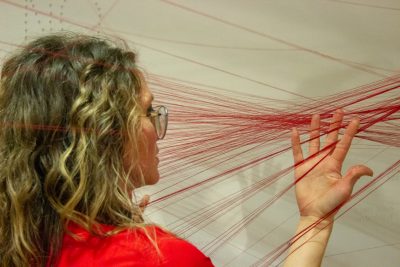
Installation artist Marika Whitaker has grappled with the idea of power dynamics, particularly within intimate relationships, and explored it through her work for many years. That dynamic is the crux of her most recent installation, titled “CONSENT,” in which Whitaker said she challenges visitors to consider the “nuance of ‘yes’ and ‘no.’”
However, Whitaker said unlike her previous exhibitions, this one is participatory. It’s also inside of a bathroom.
Situated inside Spaceus, a communal exhibition space for artists in Cambridge, “CONSENT” spans all four walls of a single occupancy restroom, as well as all the spaces in between. In one corner, Whitaker arranged a series of pushpins to say “yes” with those in the opposite corner spelling out “no.” In between the two, the words “maybe so” are repeated.
Using this framework, community members were invited to interact with the art at the exhibit’s opening reception Monday night. Over drinks, snacks and conversation, guests could thread a red string between the various pins, stretching and criss-crossing it over the ceiling and walls.
“This material [the red string] is already very dynamic for me as an artist,” Whitaker said. “It changes. It feels very alive. The string never looks the same when I come in, but having that dimension of feeling the presence of other people in the space and other touches and traces, … I really love it.”
On the blank spaces of the walls, Whitaker invited guests to write commentary, particularly on how they say each of the pinned phrases. Exhibit-goers also responded to what others wrote, which Whitaker equated to the messages on a typical bathroom stall.
Whitaker said she always loved the communal aspect of reading those notes, and especially the manner in which everyone uses the intimate space of a bathroom. She said she hoped this exhibit would help to push the conversation surrounding consent forward.
While she emphasized the necessity of the #MeToo movement to be “all about smashing the patriarchy,” she said it was also important to consider what comes next.
“If we smash these codependent systems in which gender dynamics is based, we have to learn to take full responsibility for ourselves,” she said. “I think that that means really knowing ourselves and knowing and honoring our own ‘yes’s’ and ‘no’s’ and listening to ourselves and being able to communicate them.”
These questions are ones Spaceus curator Ally Campbell said she has grappled with since Whitaker approached her about the installation. While most artists require her logistical support, Campbell said the nature of “CONSENT” allowed her to step back and consider the process and meaning of the piece.
She described watching Whitaker install the exhibit and its evolution as a “gradual but kind of collective experience.” After seeing the growing number of messages on the walls and participating herself, she said she learned more about herself and the way she could say one thing and mean another.
“Not only does it create a space where it’s kind of a cacophony of different voices and of different phrases, but it creates a physical conversation with other people,” she said.
Participant Bethany Davis, 36, of Beverly, said she had a similar experience of self-reflection. She explained the exhibit made her question her own relationship with consent. While she said she is a verbal and clear person, she explained she sometimes doesn’t “check in with all the parts of [herself].”
“A lot of the insights and reflections around consent, I’m internalizing them and thinking about the different parts of myself,” Davis said.
Davis said one written comment that stuck with her centered on the notion of saying “yes” in fear of judgment for saying “no.”
Another was a text bubble with three dots, she said, like the one that appears when someone is typing. For Davis, this represented the period of consideration before agreeing, and how overthinking typically leads to a “forced ‘yes.’
“I thought about it, and if I actually checked every time I did anything, if I actually checked if I had a whole body ‘yes’ before doing it,” she said, “I think I would do far less than I do.”


















































































































